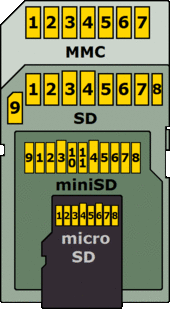
For the moment, SD card has three physical sizes and we can classify them into full-size SD card, miniSD card and microSD card. Full-size SD card is the original format of SD memory card, it comes with the size of 32mm x 24mm x 2.1mm. An SD card’s speed class is identified on the SD card itself—just look for the logo. You’ll also see the speed class on the online store listing or on the card’s packaging when purchasing it. For example, in the below photo, the middle SD card is speed class 4, while the two other cards are speed class 6.
(tl;dr – skip to bottom for instructions, see also ) The CID register on SD cards is supposed to be read-only, which means it can be used to lock devices to specific SD cards, preventing the user swapping them out, which is very annoying. This can result in you being stuck with a smaller card than you’d like in a device or not being able to use a backup in case of damage. I’ve spent a while trying to work out how to change the ID on some cards. There is surprisingly little info out there about this, when it’s easy for other devices. For example, if you want to change the supposedly read-only ID on various kinds of RFID tag you can simply buy a special version from China that allows it (often referred to as gold or magic cards).
There are rumours of cheap Chinese SD cards that don’t follow the official spec and allow you to change to them – I now have large pile of cheap Chinese SD cards on my desk, but unfortunately none of them did allow it. The spec includes a command (CMD26) for writing the CID, but it’s only supposed to work once in the factory when the card is first assigned an ID. All the cards I got seemed to honour that restriction. However, there is probably some way to unlock them If you’ve found this page by looking for help on this topic you’ve probably already seen Bunnie Huang’s SD card hacking presentation, unfortunately I wasn’t able to track down any APPO AX211 based cards, which I thought would be my best bet. In that presentation was mention of vendor commands for a Samsung eMMC used as the built-in storage on an Android phone.
I’m not well enough versed on the technology to know quite what the difference between eMMC and SD cards are, aside from the way SD cards are packaged of course – although that might be all there is to it. Reading around they seem work in the same way and appear the same within Linux. Then I stumbled upon, where Sean Beaupre had managed to unlock a Samsung phone (to developer mode) by reverse engineering some of the eMMC firmware on his device and finding commands that allowed the CID to be unlocked and rewritten. So I started buying Samsung SD cards, hoping for one with the same moviNAND core as the eMMC in their phones. I now also have a stack of Samsung SD cards on my desk, but with the last different one I found I struck gold! (Collecting Samsung cards is more expensive than cheap Chinese ones and it takes some effort to avoid getting fakes.) The Samsung EVO Plus 32GB MicroSDHC card took the commands from SamDunk and let me change the CID.
I have taken the SamDunk code and reworked it a little to make it easier to use for SD cards, but all the credit really needs to go to the original author. To use you simply need a rooted Android device with an SD card slot.

Copy the evopluscid binary to the device and put it somewhere with a proper Linux file system (not FAT), then apply execute permission to it. Run the tool and point it to the SD card device e.g. /dev/block/mmcblk1 (you almost certainly do not want to use mmcblk0, that is likely to be the built-in storage on your device). List the /dev/block folder and make sure the device you going to use appears and disappears as you insert and remove the SD card to be sure. Supply the new CID you want to set on the command line.
If you only need to change the card serial number (part of the CID) you can supply the old CID and the new serial number and the new CID will be calculated for you. I suggest you make a note of the old CID first, in case you want to set it back later.
This can be found in the file like /sys/class/mmchost/mmc1/mmc1:0001/cid, but the path may vary, and again make sure you are looking at the right card by checking it disappears when you remove the card. You can find the code here: (compiled binary is in the lib folder). Use entirely at your own risk. Use only against genuine Samsung Evo Plus cards, anything else is unlikely to work and could be damaged.

Even the right card could potentially be damaged! To set a new completely new CID: # Usage:./evopluscid./evopluscid /dev/block/mmcblk1 744a454e2f412020106c6d77470104c3 Or to just change the serial number part of the current CID: # Usage:./evopluscid./evopluscid /dev/block/mmcblk1 1b5deb0102a1 12345678 Post navigation. Hi Richard, I know this is an old post, just wanted to thank you, as I managed to change the CID on a 64gb Samsung Evo (no plus). Now, I am facing the next challenge the purpose is to update the maps on an rns315, which requires the card to be password locked. As my only way of accessing the card via mmc is through an Android phone, I was wondering if you had taken this project another step ahead or if you know how to do it. I know what password to set, according to my custom cid, but i haven’t found a way of setting it via adb shell i order to lock the card.
@modimo @Richard Actually that kind of tool already exists using something like a cheap “Blue Pill” STM32 and even it can independently check whether the card supports the back door or not. The fact is that indeed when you have the right cards, that kind of device is by no means indispensable, just as EVOPLUSCID is not even (honestly speaking), simply send the right commands via SPI protocol is the easiest and cleanest way. Even if nowadays Linux can do it without the need for anything else, as Android, Windows nor other kind of OS, that isn’t the better way, IMHO: SPI it is. The device in question isn’t a standalone cid programmer for compatible cards. It’s an sd card sized device that takes a microsd card for storage and passes everything through, except cid requests which it responds to itself. A neat device and on topic.
However the site is just a signup page where you can register your interest in something that isn’t actually available. As such I deemed the post above to be an advertising post to drive traffic to something the guy is planning to sell. Once it’s available and if it’s demonstrated to be good I might well choose to link to it. Sorry Richard.
I think I haven’t expressed myself quite clearly, my fault. The device I’ve written really exists and among other things is a standalone CID programmer/tester for compatible cards. Being based on an ARM microcontroller, wanting it can be setup in order to spoof CID too.
It is need an optional adapter though, because otherwise there is no way to put it into the host reader where it is need the spoofed CID. Even though I don’t know the device and I haven’t seen it yet, what modimo wrote is in fact an sd card sized device that takes a microsd card for storage and passes everything through, except CID requests which it responds to itself, so that it can spoof the actual CID with a dummy one.
Surely, as you wrote, an interesting device which deserve attention, but nothing has to do with the ability to alter or rewrite the CID of the cards, compatible or not because actually there aren’t only Samsung EVO+, also other kind and brands allows for that. Hello Richard, firstly thank you for such detailed description how to proceed with CID change. I am happy I’ve found this place! Now referring to the latest Samsung Evo+ cards, I need to inform potential users that new cards purchased in March 2017 do not allow modification of CID. I have tested 3pcs of 32GB (MB-MC32DA/EU) cards and 2pcs of 64GB (MB-MC64DA/EU). All of them were bought from the official distributors of Samsung in Poland. Currently I am waiting for delivery of another 32GB card purchased via Aliexpress.
I do hope this one will finally work as expected. Maybe some of you have such unnecessary card – I would like to buy it or exchange with ones I have. I am open to any suggestions 🙂 Best regards, Leszek. Hi, i try to change cid but i have little problem 1. It say ‘s to me ioctl: Connection timed out Unlock command failed. If i repeat command then unlock command failed. Repeat again then Failed to enter vendor mode.
Genuine Samsung Evo Plus? So what is wrong? All information about card is here Samsung evoplus 32gb oot@ubuntu:/Desktop/evopluscid/jni#./evopluscid /dev/mmcblk0 744a454e2f412020106c6d77470104c3 Unlock command failed. Root@ubuntu:/Desktop/evopluscid/jni#./evopluscid /dev/mmcblk0 744a454e2f412020106c6d77470104c3 Failed to enter vendor mode. Genuine Samsung Evo Plus?
Root@ubuntu:/Desktop/evopluscid/jni#./evopluscid /dev/mmcblk0 744a454e2f412020106c6d77470104c3 Failed to enter vendor mode. Genuine Samsung Evo Plus? Root@ubuntu:/Desktop/evopluscid/jni# cat /sys/block/mmcblk0/device/cid 1b503010829b5d02010b01 root@ubuntu:/Desktop/evopluscid/jni# ls -l /sys/block grep mmc lrwxrwxrwx 1 root root 0 Dec 17 20:43 mmcblk0 -./devices/pci00:00:1c.3/0000:04:00.0/rtsxpcisdmmc.0/mmchost/mmc0/mmc0:0001/block/mmcblk0 root@ubuntu:/Desktop/evopluscid/jni#. Hello, Thanks for the answer. I was compiling on raspberry pi and got: evopluscid.c: In function ‘programcid’: evopluscid.c:58:19: warning: cast from pointer to integer of different size -Wpointer-to-int-cast idata.dataptr = (u64)cid; ^ evopluscid.c: In function ‘parseserial’: evopluscid.c:107:7: warning: incompatible implicit declaration of built-in function ‘strlen’ if ((strlen(str) 2) && (str0 ‘0’) && ^ evopluscid.c: In function ‘main’: evopluscid.c:135:8: warning: incompatible implicit declaration of built-in function ‘strlen’ len = strlen(argv2); ^ is that okay should i ignore it?
Sd Card Label Meanings
The backups are saved to the backup+restore folder on the SD card. Contacts are stored as a single vcf file while SMS are stored as a xml file. Restoring Backed up Contacts, SMS and MMS You can restore the backups to the same Windows Phone device on which the backup was made or on any other Windows Phone device which supports an SD Card. Here’s how to do that.
Install the contacts+message backup app if not already installed. Insert the SD card or Transfer the backup+restore folder to the SD card of the Windows Phone on which the contents are to be restored. Go to Settings contacts+message backup and choose restore. Tick the items to restore and then select the restoration point that should be used for restoring the contents (if there are more than 1 backups stored to the SD card).
Sd Card Numbers Explained
Tap on restore to begin the restoration process.
